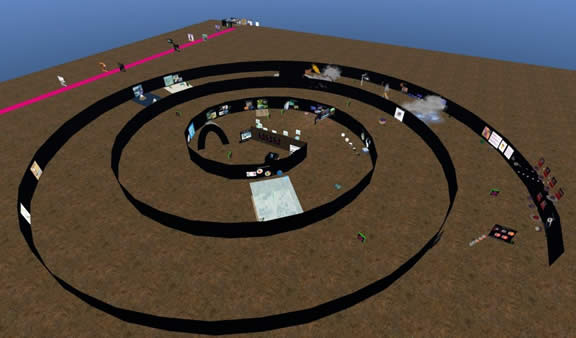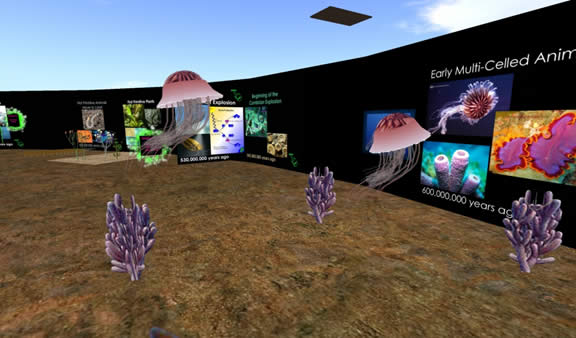© 2008 Adrienne Gauthier and Christopher Impey
EDUCAUSE Review, vol. 43, no. 5 (September/October 2008)
ASTR202, Exploring Life in the Universe
The virtual world called Second Life (SL) was introduced to undergraduate students at the University of Arizona in the course “Exploring Life in the Universe†during the Spring 2007 and Spring 2008 semesters. The course is designed for non-science majors who need to fulfill their natural sciences university requirement. The course, given by Professor Christopher Impey, includes a creative project worth one-sixth of the final grade. Creative projects require using real course content and concepts as inspiration for a personally motivated creative piece. Past projects have included astrobiology-inspired paintings, sculpture, posters, poems, short stories, movies, songs, and multimedia experiences. Second Life was introduced as an innovative way for students to express their projects.
Support staff for Second Life included Adrienne Gauthier, whose focus is astronomy education, as well as SL mentor Chris Johnson and undergraduate “preceptors†or teaching assistants. Preceptors are enrolled in the class but receive three extra credits for putting in 100 additional hours during the semester to help the instructor. We had a range of fully stocked computer labs for use, available by reservation.
Preparation for the SL grand experiment began during the winter break of 2006–2007. Gauthier was able to immerse herself in Second Life and find the best SL education projects, the best informal education and museum builds, and the best resources to help teach students to create content in Second Life. Johnson, at the University of Arizona, helped get the project started; Impey leased a plot of land for the class.
Second Life was introduced to the class early in the semester. We showed the class how simple it is to build, toured a few high-level builds (Svarga, NOAA, International Spaceflight Museum), and discussed some possibilities for creative projects: 3D works of art, avatar apparel design, and sets for storytelling. The three preceptors for the class were specifically accepted to work on an SL project and to help classmates with Second Life.
The first step was to get the preceptors into Second Life and teach them basic avatar and building skills. Following this, a larger project idea emerged. The preceptors were to design and construct the framework for a “timeline of Earth’s history and life on Earth.†This included identifying the scale and shape of the timeline, researching important landmark points for Earth and for life, and building graphical posters and models for the topics. The basic idea was presented to the rest of the class just before spring break. It was advertised that students could pick a specific topic and create a mini-exhibit for that spot in the timeline. Just before spring break, we held extra-credit open labs for students to create an avatar, tour Second Life, and get a feel for the possibilities. A quarter of the class participated, and of those twenty-four students, only seven showed interest in the creative project and six followed through to completion. Including the preceptors, we had nine students in the class creating content in Second Life during the Spring 2007 semester.
The project came together very well, and the students were generally excited about Second Life. The preceptors kept to a production schedule as they built the spiral-shaped scale-model timeline and placed content into approximately twenty-five landmarks of Earth’s history. They were successful in creating imagery for billboards that dispensed notecards and in making 3D models. One group of students chose to create a story box and models for a work of fiction based on real science (extremophiles). A second group placed a piece of content into the timeline. Each preceptor also created an additional piece of content for the timeline to fulfill his or her creative project class requirement.

Bird’s-eye View of the “Timeline of Earth†Spiral, 4.6 Billion Years Ago (Outside) to the Present (Inside)

The “Timeline of Earth†Spiral near the Cambrian Explosion, 600 Million Years Ago
Overall, the experience was rewarding for the students. Support for students was individual, though a few group labs were scheduled to get students the necessary SL and Photoshop skills to be successful content creators. Weekly meetings and reviews were held with the preceptors. In the end, the students created a wonderful SL exhibit that still averages about ten visitors per day and often has larger tour groups go through.
The effort for the Spring 2008 semester began with a showing of the “Timeline of Earth†project from the previous semester. A few weeks later, an extra-credit assignment worth more points was offered to the class. They were to create an avatar, to learn movement, camera, and communication basics, and to review one of three science-themed exhibits. We offered forty hours of available time slots for students to fit the extra-credit opportunity into their schedules. Approximately sixty students participated in the exercise, with mixed reviews. Some were excited by the opportunities, and some saw no point to Second Life. Skill levels varied, though most students grasped the avatar basics easily.
Twelve students decided to pursue creative projects in Second Life, and the deliverables were amazing. In addition to scheduled building and scripting labs at the beginning, we held ten to sixteen hours of staffed open labs during the week. This allowed students to come in and create content with Gauthier and a hired hand (a preceptor from the Spring 2007 semester). Students (in groups and singly) in Spring 2008 took the content creation to a level higher, as we stressed the use of storytelling in their exhibits, helping them understand how to communicate scientific content to the public. A few students had advanced skills and tackled scripting, multimedia, and sculpted prims. Judged from how they worked in open labs, the students seemed to enjoy the overall experience and were proud of their work. There was minimal frustration, although this may have been due to the personalized assistance they received. Spring 2008 was more successful than Spring 2007 in a number of ways, and we feel this was because of better preparation and better-formed ideas from the instructors. We communicated much more descriptively how students could use Second Life for their creative projects.
We plan to keep using Second Life in the course and to expand the “Timeline of Earth†exhibit. Currently the exhibit sits on the Living in the Universe island (http://slurl.com/secondlife/livingintheuniverse////). Screenshots of the project, including student workspace located on the University of Arizona island, can also be viewed online (http://sites.google.com/site/timelineofearth/screenshots).
